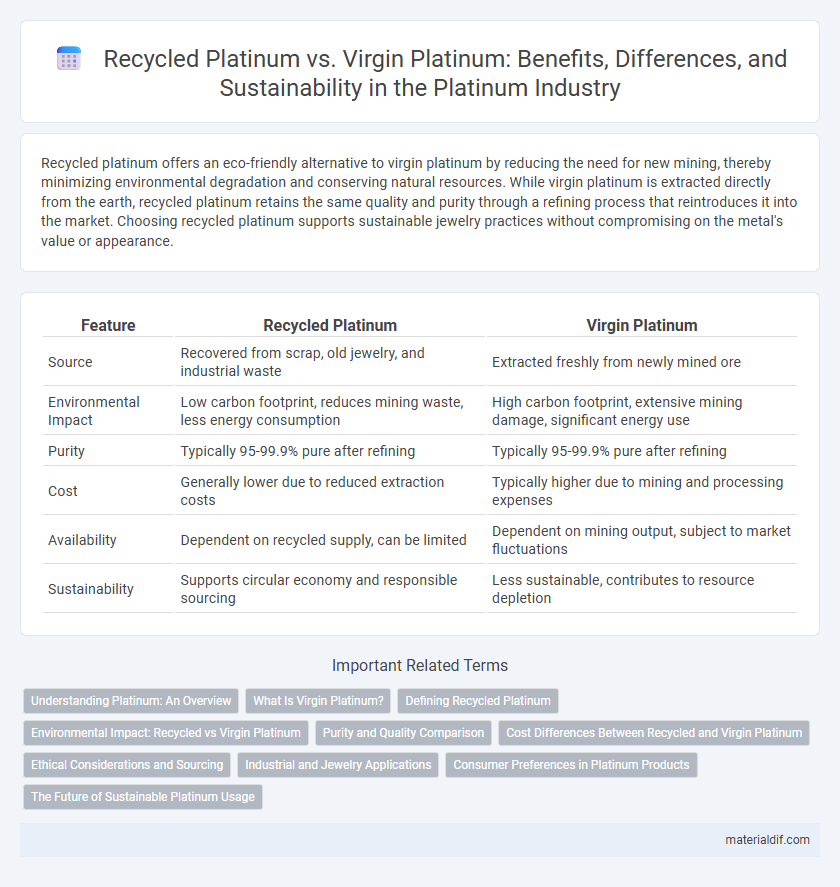Recycled platinum offers an eco-friendly alternative to virgin platinum by reducing the need for new mining, thereby minimizing environmental degradation and conserving natural resources. While virgin platinum is extracted directly from the earth, recycled platinum retains the same quality and purity through a refining process that reintroduces it into the market. Choosing recycled platinum supports sustainable jewelry practices without compromising on the metal's value or appearance.
Table of Comparison
| Feature | Recycled Platinum | Virgin Platinum |
|---|---|---|
| Source | Recovered from scrap, old jewelry, and industrial waste | Extracted freshly from newly mined ore |
| Environmental Impact | Low carbon footprint, reduces mining waste, less energy consumption | High carbon footprint, extensive mining damage, significant energy use |
| Purity | Typically 95-99.9% pure after refining | Typically 95-99.9% pure after refining |
| Cost | Generally lower due to reduced extraction costs | Typically higher due to mining and processing expenses |
| Availability | Dependent on recycled supply, can be limited | Dependent on mining output, subject to market fluctuations |
| Sustainability | Supports circular economy and responsible sourcing | Less sustainable, contributes to resource depletion |
Understanding Platinum: An Overview
Recycled platinum offers a sustainable alternative by repurposing existing metal without the environmental impact of mining virgin platinum, which involves extensive extraction processes. Virgin platinum, sourced directly from mines, typically has higher energy consumption and ecological footprint due to mining and refining activities. Understanding platinum highlights the balance between environmental responsibility and the demand for high-quality, durable precious metal used in jewelry, automotive catalytic converters, and industrial applications.
What Is Virgin Platinum?
Virgin platinum refers to platinum that is extracted directly from natural mineral ores through mining processes, ensuring high purity and quality for industrial, jewelry, and catalytic applications. Unlike recycled platinum, virgin platinum is sourced fresh from geological deposits, making it more abundant initially but associated with higher environmental and energy costs due to extensive mining and refining activities. This form of platinum is critical in sectors requiring pristine metal properties and consistent performance standards.
Defining Recycled Platinum
Recycled platinum refers to platinum that has been recovered from used jewelry, industrial products, and electronic components through refining processes to restore its purity. This sustainable source reduces environmental impact by minimizing mining activities and conserving natural resources while maintaining the same quality and characteristics as virgin platinum. The growing demand for ethically sourced materials has increased the importance of recycled platinum in luxury markets and industrial applications.
Environmental Impact: Recycled vs Virgin Platinum
Recycled platinum significantly reduces environmental impact by minimizing the need for mining, which often causes habitat destruction, soil erosion, and water pollution. Virgin platinum extraction involves energy-intensive processes and releases hazardous chemicals, contributing to greenhouse gas emissions and biodiversity loss. Choosing recycled platinum supports sustainable resource management and lowers the carbon footprint associated with precious metal supply chains.
Purity and Quality Comparison
Recycled platinum maintains a high purity level, often exceeding 95%, comparable to virgin platinum extracted directly from ores. The refining process for recycled platinum removes impurities effectively, ensuring that its quality matches or surpasses that of newly mined platinum. Both forms exhibit excellent durability and are indistinguishable in performance for industrial and jewelry applications.
Cost Differences Between Recycled and Virgin Platinum
Recycled platinum typically costs 20-40% less than virgin platinum due to lower extraction and refining expenses, reducing overall production costs. The price gap is influenced by market demand, supply chain efficiencies, and environmental regulations favoring sustainable sourcing. Investors and manufacturers increasingly prefer recycled platinum for its cost-effectiveness and reduced environmental impact without compromising quality.
Ethical Considerations and Sourcing
Recycled platinum offers significant ethical advantages over virgin platinum by reducing the demand for environmentally damaging mining practices and minimizing the exploitation of labor in mining regions. Virgin platinum extraction often involves extensive land disruption, high energy consumption, and socio-economic challenges for local communities. Choosing recycled platinum supports sustainable sourcing, promotes responsible resource management, and aligns with growing consumer demand for ethically produced precious metals.
Industrial and Jewelry Applications
Recycled platinum offers a sustainable alternative to virgin platinum, reducing environmental impact while maintaining high purity levels essential for industrial and jewelry applications. In industries such as automotive catalytic converters and electronic components, recycled platinum delivers the same performance and durability as newly mined metal. Jewelry manufacturers increasingly favor recycled platinum to meet consumer demand for ethically sourced materials without compromising on refinement and luster.
Consumer Preferences in Platinum Products
Consumer preferences in platinum products increasingly favor recycled platinum due to its environmental sustainability and ethical sourcing. Recycled platinum offers the same purity and quality as virgin platinum, making it a popular choice for eco-conscious buyers seeking luxury without compromising on performance. Market trends indicate a growing demand for recycled metals, aligning with broader shifts toward responsible consumption in the jewelry and industrial sectors.
The Future of Sustainable Platinum Usage
Recycled platinum significantly reduces environmental impact by minimizing mining activities and conserving natural resources, aligning with global sustainability goals. As demand for eco-friendly luxury goods and green technologies rises, the market share of recycled platinum is expected to increase, driving innovation in refining and recycling techniques. Embracing recycled platinum supports circular economy principles, ensuring a sustainable supply chain for industries such as automotive, electronics, and jewelry.
Recycled Platinum vs Virgin Platinum Infographic

 materialdif.com
materialdif.com